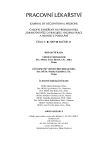Noise as a risk factor in school facilities
Authors:
P. Sachová 2; E. Mrázková 1,2; M. Menzlová 2; K. Richterová 2; R. Sachová 4; V. Janout 2,3
Authors‘ workplace:
Klinika pracovního a preventivního lékařství FN Ostrava, přednostka MUDr. Zdeňka Hajduková, Ph. D.
1; Ústav epidemiologie a ochrany veřejného zdraví FZS OU Ostrava
vedoucí prof. MUDr. Vladimír Janout, CSc.
2; Ústav preventivního lékařství LF Univerzity Palackého v Olomouci
přednostka doc. MUDr. Helena Kollárová, Ph. D.
3; Katedra algebry, Matematicko-fyzikální fakulta Univerzity Karlovy v Praze
vedoucí doc. RNDr. Jiří Tůma, DrSc.
4
Published in:
Pracov. Lék., 61, 2009, No. 4, s. 182-187.
Category:
Original Papers
Overview
The aim of the study was to find out the difference between the noise load in teachers teaching noisy and quiet subjects at primary schools and kindergartens in Karviná. The quality of hearing was examined using screening tone audiometry, the examination was accompanied by an original questionnaire. The whole sample was divided into two categories (noisy and quiet) in relation to exposure to noise during the classes. Results were evaluated using average audiograms, hearing losses according to Fowler, biological risk assessment and statistical analyses.
The hypothesis of the study was confirmed. Teachers of a noisy category have nearly twofold hearing loss compared to teachers teaching more quiet subjects. The hearing loss in the noisy category was 0.79 dB, in a quiet one 0.49 dB. The quality of hearing is deteriorating in relation to length of practice faster in a noisy category.
The authors recommend considering implementation of regular audiological examinations in teachers since preventive measures are quite limited. The society should focus on lowering the communal noise and the noise in school environment.
Key words:
teacher, length of practice, noise, noisy and quiet category, tone audiometry, hearing loss
Sources
1. CORZINE, J. S. Public Employees Occupational. In Public Employees occupational. New Jersey [s. n.], 2005. 12 s.
2. KRAHULEC, J. Vliv hluku na zdraví člověka. 1. vyd. Praha: OZV KÚNZ SKNV, 1985, 19 s.
3. MENZLOVÁ, M. et al. Biologické hodnocení rizika komunálního hluku : Dílčí výsledky epidemiolgické studie. [s. l.] : [s. n.], 2007. s. 1–22.
4. Answers: Image: Ath-byage.png [online], 2004, 23. 10. 2003 [cit. 2007-03-12], dostupné na www:
<http://www.answers.com/topic/ath-byage-png>.
5. Hluk v číslech [online]. Evropská agentura pro bezpečnost a ochranu zdraví při práci, 2006 [cit. 2009-08-26], dostupné na www: <http://osha.europa.eu/cs/publications/factsheets/67>. ISSN 1725-7018.
6. JIANG, T. Can Noise Levels at School Gymnasia Cause Hearing Loss: A Case Study of a Physical Education Teacher [online]. Kanada: 1997 [cit. 2009-04-08], dostupné na www: http://www.acoustics.org/press/133rd/2paaa7.html
7. MARKVART, K. Hluk ve školách – Česká republika [online]. Světová zdravotnická orga0nizace, 2006 [cit. 2009-01-30], dostupné z www: http://www.bozpinfo.cz/knihovna-bozp/citarna/clanky/clanky_skolstvi/ceske_skolstvi_hluk.html
8. Noise in schools – hazards and solutions [online]. NJEA, 2009 [cit. 2009-04-12], dostupné na www:
<http://www.njea.org/pdfs/HS_Noise_March09.pdf. >
9. SARKOZI, R. Měli by učitelé dostávat příplatky za hlučné pracovní prostředí? Nejhlučnější práce? Učitelka ve školce [online]. MF DNES, 2005 [cit. 2009-04-09], dostupný na www: 10. SCHONWALDER, H. G. et al. Noise in School: Causes and Reduction. Federal institute for occupational safety and health [online], 2008 [cit. 2009-08-26], s. 18, dostupné na www: http://www.baua.de/nn_33068/en/Publications/Research-reports/2004/Fb1030,xv=lf.pdf
11. SCHREIBER, G. Spokojenost na pracovišti a zdraví v učitelském povolání [online]. 2003 [cit. 2009-02-20], dostupné na www: http://www.bozpinfo.cz/knihovna-bozp/citarna/clanky/clanky_skolstvi/zdravi030714.html, ISSN 1801-0334.
12. ŽÍDKOVÁ, Z., MARTINKOVÁ, J. Psychická zátěž učitelů základních škol [online]. Brno: Výzkumný ústav bezpečnosti práce, 2004 [cit.2009-02-20], dostupné na www: http://www.bozpinfo.cz/knihovna-bozp/citarna/clanky/clanky_skolstvi/sters_ucitelu040910.html , ISSN 1801-0334.
Labels
Hygiene and epidemiology Hyperbaric medicine Occupational medicineArticle was published in
Occupational Medicine

2009 Issue 4
Most read in this issue
- Risk factors at work in the bakery
- Working positions – experience from the practice of physiological measurements
- Noise as a risk factor in school facilities
- Significance of measuring skin temperatures in diagnostics of the Raynaud syndrome from vibrations
